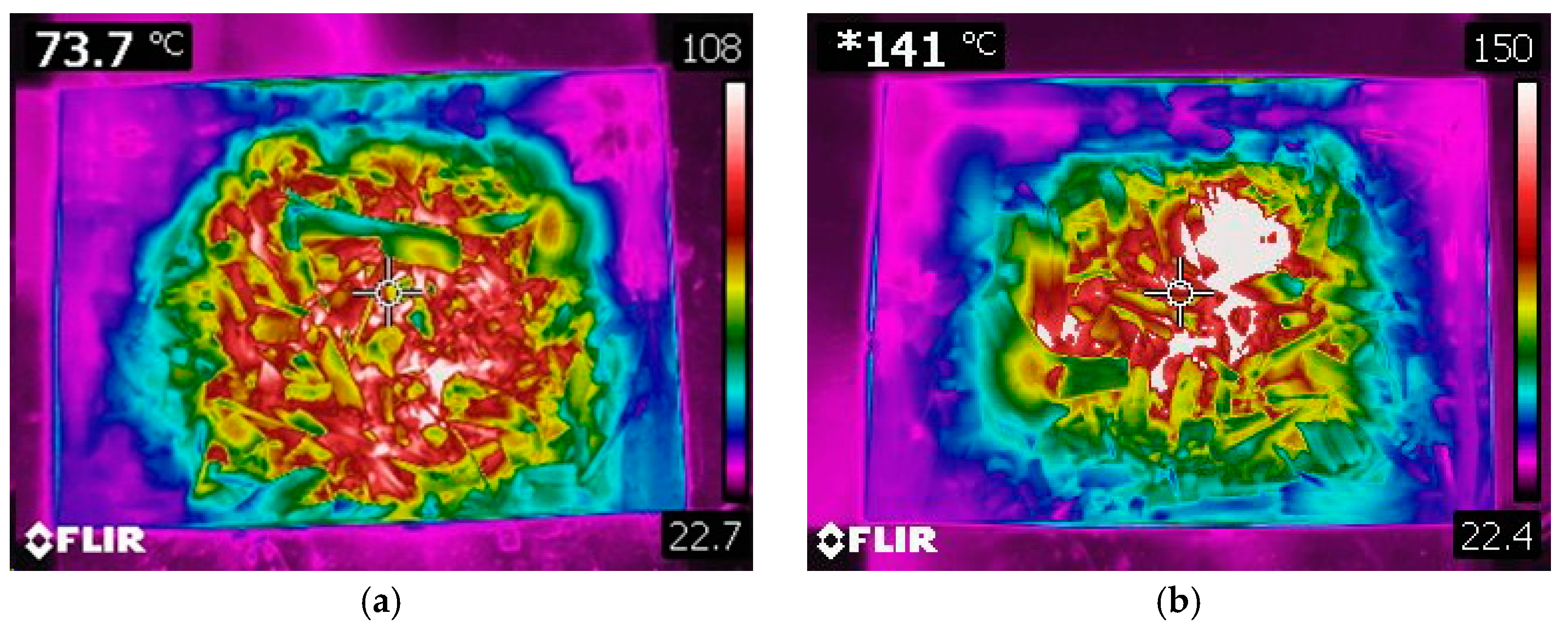Effects of Microwave Drying on Moisture Content Depending on Wood Chip Size Distribution †
Abstract
:1. Introduction
2. Materials and Methods
3. Results
4. Conclusions
Author Contributions
Funding
Conflicts of Interest
References
- Picchio, R.; Spina, R.; Sirna, A.; Monaco, A.L.; Civitarese, V.; Giudice, A.D.; Suardi, A.; Pari, L. Characterization of Woodchips for Energy from Forestry and Agroforestry Production. Energies 2012, 5, 3803–3816. [Google Scholar] [CrossRef]
- Li, X.; Zhang, B.; Li, W.; Li, Y. Research on the effect of microwave pretreatment on moisture diffusion coefficient of wood. Wood Sci. Technol. 2005, 39, 521–528. [Google Scholar] [CrossRef]
- Krajewski, A. Zwalczanie owadów—Szkodników technicznych drewna za pomocą mikrofal. Ochrona Zabytków 1990, 43, 27–34. [Google Scholar]
- Fizyczne Metody Dezynsekcji Drewna dóbr Kultury [Physical Methods of Wood Desinsectisation in Monuments Culture]; Rozprawy Naukowe i Monografie; Wydawnictwo SGGW: Warszawa, Poland, 2001; Volume 242.
- Wang, X.; Chen, H.; Luo, K.; Shao, J.; Yang, H. The Influence of Microwave Drying on Biomass Pyrolysis. Energy Fuels 2007, 22, 67–74. [Google Scholar] [CrossRef]
- Du, G.; Wang, S.; Cai, Z. Microwave drying of wood strands. Dry. Technol. 2005, 23, 1–16. [Google Scholar] [CrossRef]
- Liu, H.-H.; Wang, Q.-W.; Yang, L.; Jiang, T.; Cai, Y.-C. Modification of larch wood by intensive microwave irradiation. J. For. Res. 2005, 16, 237–240. [Google Scholar] [CrossRef]
- He, X.; Xiong, X.; Xie, J.; Li, Y.; Wei, Y.; Quan, P.; Mou, Q.; Li, X. Effect of Microwave Pretreatment on Permeability and Drying Properties of Wood. BioResources 2017, 12, 3850–3863. [Google Scholar] [CrossRef]
- Lisowski, A.; Sar, Ł.; Świątek, K.; Kostyra, K. Sieve separator to analysis of chaff length distribution. Tech. Rol. Ogrod. Leś. 2008, 2, 17–19. [Google Scholar]
- PN-ISO 565:2000; Test Sieves—Metal Wire Cloth, Perforated Metal Plate and Electroformed Sheet—Nominal Sizes of Openings. Polish Committee for Standardization: Warsaw, Poland, 2000.
- ISO 3310-2:2013; Test Sieves—Technical Requirements and Testing—Part 2: Test Sieves of Perforated Metal Plate. International Organization for Standardization: Geneva, Switzerland, 2013.


| Screen No. | Particle Size mm | Pine Chips % | Birch Chips % | Cotoneaster Chips % |
|---|---|---|---|---|
| 1 | 0–3.15 | 2.8 | 5.1 | 15.2 |
| 2 | 3.15–8 | 9.3 | 29.4 | 52.4 |
| 3 | 8–16 | 21.5 | 51.1 | 26.5 |
| 4 | 16–31.5 | 45.7 | 12.3 | 4.7 |
| 5 | 31.5–45 | 14.1 | 1.1 | 0.9 |
| 6 | 45–63 | 5.3 | 0.8 | <0.1 |
| 7 | >63 | 1.3 | 0.2 | 0.3 |
| Screen Size | Time | SP | BI | SC | ||||||
|---|---|---|---|---|---|---|---|---|---|---|
| mm | s | B | A | D | B | A | D | B | A | D |
| 16 | 30 | 68.8 ± 2.1 | 64.6 ± 1.8 | 4.2 | 33.3 ±0.7 | 30.2 ± 0.7 | 3.2 | 27.3 ± 4.7 | 18.0 ± 4.8 | 9.3 |
| 60 | 69.0 ± 2.7 | 47.8 ± 1.6 | 21.2 | 37.5 ±2.6 | 24.9 ± 2.6 | 12.6 | 28.5 ± 1.0 | 16.6 ± 2.3 | 11.9 | |
| 8 | 30 | 75.7 ± 4.1 | 71.6 ± 3.4 | 4.1 | 35.7 ±1.0 | 33.1 ± 1.7 | 2.6 | 33.5 ± 1.5 | 31.1 ± 0.1 | 2.4 |
| 60 | 72.0 ± 13.3 | 51.6 ± 10.4 | 20.3 | 29.9 ±0.9 | 16.6 ± 1.3 | 13.3 | 38.3 ± 0.9 | 25.2 ± 0.6 | 13.1 | |
| 3.15 | 30 | 68.8 ± 15.0 | 66.3 ± 14.3 | 2.5 | 37.1 ±5.0 | 34.9 ± 4.3 | 2.3 | 37.5 ± 0.5 | 35.7 ± 0.1 | 1.8 |
| 60 | 81.4 ± 6.7 | 61.0 ± 5.3 | 20.4 | 40.9 ±1.9 | 31.5 ± 0.8 | 9.4 | 40.0 ± 3.2 | 28.3 ± 2.0 | 11.7 | |
| 90 | 81.0 ± 7.1 | 46.0 ± 5.5 | 35.1 | 43.9 ±2.5 | 22.3 ± 3.5 | 21.6 | 42.4 ± 0.1 | 18.9 ± 2.0 | 23.4 | |
| bottom | 30 | 59.7 ± 1.7 | 57.5 ± 1.5 | 2.2 | 39.8 ±3.2 | 38.9 ± 2.7 | 0.9 | 49.8 ± 2.6 | 48.4 ± 2.3 | 1.4 |
| 60 | 56.2 ± 4.8 | 35.6 ± 4.1 | 20.6 | 38.9 ±1.2 | 29.0 ± 0.9 | 9.9 | 50.5 ± 1.6 | 40.0 ± 1.3 | 10.5 | |
| 90 | 54.7 ± 6.2 | 23.1 ± 3.3 | 31.6 | 30.7 ±2.2 | 12.5 ± 0.7 | 18.2 | 52.7 ± 0.7 | 29.5 ± 0.5 | 23.2 | |
Publisher’s Note: MDPI stays neutral with regard to jurisdictional claims in published maps and institutional affiliations. |
© 2020 by the authors. Licensee MDPI, Basel, Switzerland. This article is an open access article distributed under the terms and conditions of the Creative Commons Attribution (CC BY) license (https://creativecommons.org/licenses/by/4.0/).
Share and Cite
Aniszewska, M.; Gendek, A.; Malaťák, J.; Tamelová, B.; Smyl, S. Effects of Microwave Drying on Moisture Content Depending on Wood Chip Size Distribution. Environ. Sci. Proc. 2021, 3, 54. https://doi.org/10.3390/IECF2020-07765
Aniszewska M, Gendek A, Malaťák J, Tamelová B, Smyl S. Effects of Microwave Drying on Moisture Content Depending on Wood Chip Size Distribution. Environmental Sciences Proceedings. 2021; 3(1):54. https://doi.org/10.3390/IECF2020-07765
Chicago/Turabian StyleAniszewska, Monika, Arkadiusz Gendek, Jan Malaťák, Barbora Tamelová, and Sebastian Smyl. 2021. "Effects of Microwave Drying on Moisture Content Depending on Wood Chip Size Distribution" Environmental Sciences Proceedings 3, no. 1: 54. https://doi.org/10.3390/IECF2020-07765
APA StyleAniszewska, M., Gendek, A., Malaťák, J., Tamelová, B., & Smyl, S. (2021). Effects of Microwave Drying on Moisture Content Depending on Wood Chip Size Distribution. Environmental Sciences Proceedings, 3(1), 54. https://doi.org/10.3390/IECF2020-07765







